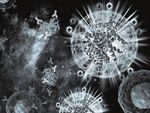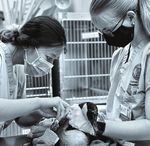EZR EXTRA - May/June 2021
←
→
Page content transcription
If your browser does not render page correctly, please read the page content below
CORNELL This special section, a bonus issue of the university’s
EZR\
Ezra magazine, highlights ways Cornell initiatives
UNIVERSITY’S intersect with philanthropy and engagement of Cornell
MAGAZINE alumni, parents and friends.
EXTRA
SHAOYI JIANG: PROTECTIVE
MATERIALS THAT MIMIC WATER
By Jackie Swift
Shaoyi Jiang, Ph.D. ’93, is the Robert S.
Langer ’70 Family and Friends Professor
in the Meinig School of Biomedical
Engineering. His research focuses
on the molecular understanding,
design and development of functional
zwitterionic materials for biomedical
and engineering applications.
continued on next page
Jason Koski
M AY | JUNE 2 02 1 61
MA21_gardens_PROOF_3.indd 61 4/28/21 7:55 AM“A ZWITTERIONIC MATERIAL
LOOKS JUST LIKE WATER. THAT’S
WHY YOU CAN PUT IT ON THE
SURFACE OF A MEDICAL IMPLANT
... AND OUR IMMUNE SYSTEMS
WON’T ATTACK IT.”
Bowen Li
– Professor Shaoyi Jiang, Ph.D. ’93
Biocompatibility is an enduring challenge for PEG as protection for a drug, and our immune
medical applications. Our immune systems systems won’t attack it.”
90
are adept at identifying foreign bodies, then In 2013, Jiang and his collaborators excited
rendering them harmless: encapsulating them the biomedical world when they published a
in collagen to isolate them, attempting to paper in Nature Biotechnology showing that
dissolve them with enzymes, or generating implants coated in their zwitterionic material
antibodies to kill them. The trouble is, our lasted three months without encapsulation in
bodies see every intruder as an enemy – animal models. Until that breakthrough, the
whether it’s a dangerous virus or a life-saving standard timeline for non-encapsulation was percentage of marine
medical implant. one month. coating products that
This problem has come to the fore recently in “In 2016, Nature Biotechnology chose our keep hulls free of
the development of the groundbreaking mRNA work as one of eight major biomedical
vaccines for COVID-19, explains Shaoyi Jiang,
fouling organisms
research ‘hits’ published in the journal over
professor of biomedical engineering. These the previous 20 years,” says Jiang. “A reporter by releasing heavy
vaccines feature polyethylene glycol (PEG) as from the magazine asked me my future metal ions and
a stabilizing coating around the mRNA cargo, plans, and I told her I was going for the next biocides. By contrast,
preventing it from being destroyed by the milestone because we only showed three
body before it can stimulate the production of zwitterionic material
months without encapsulation and I thought
COVID-19 antibodies. we could go further than that.” is nontoxic, essentially
Occasionally a patient may have an allergic In January, Jiang and his co-authors published coating the hull in a
reaction to one of the vaccines, possibly due another paper in Science Advances, showing layer of water.
to overexposure to PEG, which is present no encapsulation of zwitterionic materials
in shampoos, drugs, toothpaste and other implanted in animal models for up to one year.
products. Those findings are the culmination of years
“For about 45 years now people have been of work to prove the concept of zwitterionic
using PEG in all kinds of products because it is material as biocompatible.
considered hydrophilic [water-loving],” says Nontoxic marine coatings
Jiang, who joined the Cornell faculty in 2020.
While working on the biocompatibility
“In medical applications, it is used to protect
question, Jiang also turned his attention to
drugs in the bloodstream and also implants in
another application of his new materials:
the body. Unfortunately, our bodies see it as
environmentally benign marine coatings to
------i!iUJJO
a foreign material and attack it, as it is not as
hydrophilic as one would think.”
prevent the buildup of fouling organisms on ------ltiaiJf'
ship hulls. Zwitterionic materials
Zwitterionic: fooling the immune system
“Nature is very smart, so if a material works are hybrids, carrying
PEG and the question of biocompatibility have on a particular species – for example, algae –
been central to Jiang’s research for the past 20 then it doesn’t work for some other species, one positive and one
years and led to his invention of a new class of such as diatoms (single-celled algae),” he says. negative ion, making
materials, known as zwitterionic. “When we first started testing our zwitterionic them hydrophilic
Zwitterionic materials are hybrids, carrying one material and nothing stuck to it, people said,
while neutral
positive and one negative ion, which means ‘I’ve been trying this for years, and I’ve never
they are extremely hydrophilic while neutral in seen anything like this before. Why does your in net charge.
net charge. material work for every organism?’”
“A zwitterionic material looks just like water,” The other researchers thought the answer
Jiang says. “That’s why you can put it on the must be that Jiang’s material is highly toxic.
surface of a medical implant or use it to replace “That’s because 90% of marine coating
62 CORNELL ALUMNI MAGAZINE EZRA MAGAZINE EXTRA
MA21_gardens_PROOF_3.indd 62 4/28/21 7:46 AMproducts today keep hulls free of fouling On the translational side, Jiang and his lab have
organisms by releasing heavy metal ions and begun collaborations with several groups at
organic biocides that kill anything that tries to Weill Cornell Medicine. His ultimate goal is to
stick to them,” he says. explore the application of zwitterionic material
Zwitterionic material, however, is nontoxic for a wide range of medical needs, including
and works by coating the ship hull in a layer of regenerative medicine, stem cell technology,
water, essentially making it invisible to marine tissue engineering, nanomedicine, cancer
organisms. They don’t stick to it because they immunotherapy and vaccines.
don’t recognize it, similar to how the material “Cornell offers the chance to collaborate with
fools the body into ignoring implants, Jiang so many people,” he says. “I’ve talked to many
says. His zwitterionic hull material will be researchers on the Ithaca campus and at Weill
tested soon on U.S. Navy ships. Cornell, and they’ve all been really interested in
Real-world applications working together on this.”
Over the years, Jiang has looked at ways to Innovation at the molecular level
commercialize some of the new zwitterionic When he started out, Jiang was a computational
technologies he invented. He holds 55 patents chemist; biomedical engineering was not
and founded or co-founded three startups where he expected to end up. His Ph.D. was
based on his research. Now he is beginning in chemical engineering, and his early training
a new phase of his career at Cornell with a mainly focused on molecular simulation and
two-pronged research approach that should modeling, statistical mechanics and quantum
result in more real-world innovations: one chemical calculations. Because of that, he was
stream of research focusing on the fundamental able to look at the issue of biocompatibility
understanding of biocompatibility and differently from most other researchers.
the other on translational applications for “I use the molecular view to look at how a
zwitterionic materials. Opposite page: Illustration
material works,” he says. “For example, in 2000
depicting zwitterionic
“When people have asked why my material I became interested in why PEG works as well
coatings promoting
works so well, why it works for drugs and as it does. So I used my previous training in
protein stability, enhancing
implants and antifouling, I have always said computational, molecular-level understanding
pharmacokinetics (the
that biological systems see it as water,” Jiang to study the mechanism behind PEG. When we
movement of drugs within
says. “But now I want to upgrade our science. finally realized how it works, then immediately
the body) and reducing
My group is starting to work with people in we knew why it doesn’t work as well as we
immune response.
immunology, for instance, to study how our need it to.
Below: Implanted
entire immune system responds to zwitterionic “We were able to think outside the box,” zwitterionic hydrogels resist
material. Only when we understand all the he said, “and come up with a new class foreign body reactions
details of the body’s response can we define of materials to take its place based on the in animal models. Left
what biocompatibility really is.” fundamental principles we learned.” image shows collagen walls
The current mode for testing biocompatibility formed in response to
is to implant a device and wait a month to see Jackie Swift is a freelance writer for Cornell materials commonly used in
if the body rejects it. If not, it is considered Research, where this story originally appeared. implantable devices; right
biocompatible, Jiang explains. image records collagen
“I want to know what exactly happens inside evenly dispersed in the
the body,” he says. “My ideal is to get people tissue after an engineered
from different disciplines to work together to zwitterionic hydrogel is
deal with this fundamental issue.” implanted.
Lei Zhang
M AY | JUNE 2 02 1 63
MA21_gardens_PROOF_3.indd 63 4/28/21 7:47 AMGIFTS IN ACTION
Caring for wildlife in Cornell’s own backyard
By Linda Copman
windows, the toxins they put in the environment, or their
fshing lines.
Every patient delivered to the door of the facility is
hospitalized. When the animal is well enough, it is
transferred to a licensed wildlife rehabilitator, who
prepares it for eventual release back into the wild.
The hospital also treats animals sufering from a wide
range of infectious diseases. “Cornell has recently been
instrumental in identifying new wildlife diseases through
clinical cases that have presented to the wildlife hospital,”
Childs-Sanford says.
Janet L. Swanson Wildlife Hospital
Childs-Sanford, who has been chief of service of the wildlife
hospital since 2016, reports that the number of animals
treated there is on the rise. Last year (2020) set a new
record, with about 1,750 animals admitted for care. During
the busy season, from late spring through mid-fall, the
hospital typically treats
about 300 patients each
Dr. Sara Childs-Sanford performs a re-check
month.
examination on a bobcat in 2017 to ensure a surgically
repaired leg fracture is healing properly. In non-pandemic times,
the hospital welcomes
Janet L. Swanson Wildlife Hospital
Located on Hungerford Hill, a short drive to the east of Cornell’s about 75 frst- through
main campus, the Janet L. Swanson Wildlife Hospital is a third-year Cornell
hidden treasure, providing lifesaving medical care for native veterinary students each
wild animals. The hospital provides this valuable service free year, on a volunteer basis,
of charge to residents of surrounding communities and across to assist with patient
New York state. treatments. Fourth-year
veterinary students
The majority of patients are rescued by kind-hearted people can elect to spend
who fnd an injured animal and transport it to the hospital for two weeks or more at Veterinary students Lesley Chiu, left,
emergency care. About 70% of patients are avian species, 25% the wildlife hospital as and Kaitlyn McGarvey administer
are mammals, and 5% are reptiles and amphibians. part of their clinical treatments to a Canada goose.
rotation.
“We are unique in that we are essentially an emergency hospital
where patients present as needed around the clock, without Over the past 13 years,
prior appointments,” says Sara Childs-Sanford, D.V.M. ’99, more than 1,000 donors have stepped up to support the
assistant professor of zoological medicine at the College of hospital’s work. “Donations are so important to support
Veterinary Medicine and chief of service of the Janet L. Swanson daily operations of the hospital and the care of our
Wildlife Hospital. patients,” Childs-Sanford says.
Childs-Sanford explains that most patient injuries result from
unfortunate encounters with humans, their cars, their cats, their
“Cornell has recently been instrumental in
identifying new wildlife diseases through clinical
cases that have presented to the wildlife hospital.”
EZR\ – Dr. Sara Childs-Sanford, D.V.M. ’99
64 CORNELL ALUMNI MAGAZINE EZRA MAGAZINE EXTRA
MA21_gardens_PROOF_3.indd 64 4/28/21 7:47 AMYou can also read























































